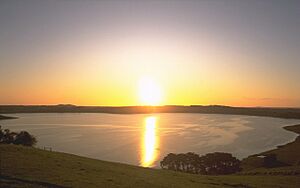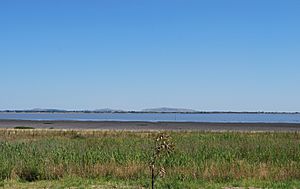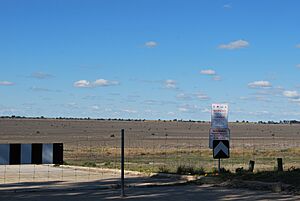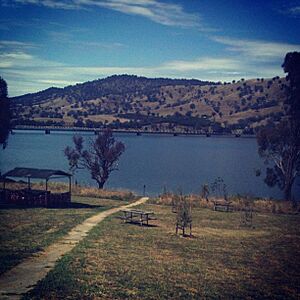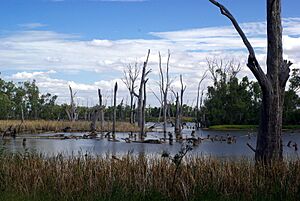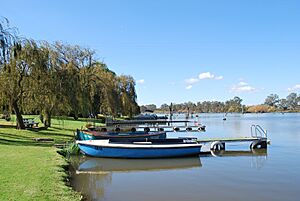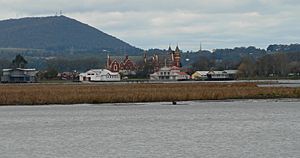Lakes and other water bodies of Victoria (Australia) facts for kids
Victoria, Australia, is home to many amazing natural lakes and other water bodies. These watery places are super important for wildlife, the environment, and even for people to enjoy! This list tells you about some of the biggest lakes in Victoria, outside of the main Melbourne area. To be on this list, a lake needs to be bigger than 70 hectares (that's about 173 acres!).
Contents
Discover Victoria's Lakes
Victoria has many different types of lakes. Some are filled with fresh water, while others are very salty. Some were formed naturally, like in old volcano craters, and some are reservoirs built by people to store water. Let's explore some of them!
Lakes of the Wimmera Region
The Wimmera region in western Victoria has some large and interesting lakes.
Lake Albacutya
Lake Albacutya is a very large lake, covering about 5,500 hectares. It's known as a eutrophic lake, which means it has lots of nutrients. This can sometimes lead to a lot of plant growth in the water. Water flows into it from Outlet Creek, but its main way of losing water is through evaporation.
Lake Buloke
Another big lake in the Wimmera is Lake Buloke, which is about 4,300 hectares. Like Lake Albacutya, it's also eutrophic. The Richardson River flows into Lake Buloke, and the water mostly leaves by evaporating into the air.
Lake Hindmarsh
Lake Hindmarsh is one of the biggest lakes in the Wimmera, stretching over 13,500 hectares! The Wimmera River feeds into this lake, and Outlet Creek flows out of it.
Lakes of the Western District
The Western District of Victoria is famous for its many lakes, especially those formed in volcanic areas.
Lake Beeac
Lake Beeac is a hypersaline lake, meaning it's very, very salty! It covers about 560 hectares. Because it's so salty, not many things can live in it. The water mostly disappears through evaporation.
Lake Bullen Merri
Lake Bullen Merri is a special crater lake, formed in the cone of an ancient volcano. It's a brackish lake, meaning its water is a mix of fresh and salt water. It's about 460 hectares in size and is a popular spot for fishing.
Lake Colac
Lake Colac is a large freshwater lake, covering about 2,800 hectares. Barongarook Creek flows into it. Like many lakes in dry areas, its water mainly leaves by evaporating.
Lake Corangamite
Lake Corangamite is the biggest lake in Victoria, covering a massive 17,000 hectares! It's a hypersaline (very salty) lake and is also endorheic, which means it doesn't have an outlet to the sea. The Woady Yaloak River flows into it, but the water stays trapped, becoming saltier over time as it evaporates.
Lake Gnarpurt
Lake Gnarpurt is another large saline (salty) lake in the Western District, about 2,350 hectares. Its water also disappears through evaporation.
Lake Purrumbete
Lake Purrumbete is another beautiful crater lake in the Western District. It's about 552 hectares and is known for its clear waters.
Lakes of Gippsland
Gippsland, in eastern Victoria, has some significant lakes, including the famous Gippsland Lakes system.
Gippsland Lakes
The Gippsland Lakes are a network of coastal lagoons and lakes. Several large lakes are part of this system.
Lake King
Lake King is a freshwater lake, about 4,400 hectares. The Tambo River and Mitchell River both flow into it, and its water eventually reaches Bass Strait.
Lake Reeve
Lake Reeve is another freshwater lake in the Gippsland system, covering about 5,200 hectares. Carr Creek flows into it, and its water also flows out to Bass Strait.
Lake Victoria (Gippsland)
This Lake Victoria, located in Gippsland, is a huge freshwater lake, about 15,000 hectares. The Latrobe River and Mitchell River are its main water sources, and its water flows to Bass Strait.
Lake Wellington
Lake Wellington is another massive freshwater lake in Gippsland, also around 15,000 hectares. The Latrobe River and Avon River feed into it, and its water flows out to Bass Strait.
Lakes of The Mallee Region
The Mallee region in northwest Victoria is known for its drier climate and unique salt lakes.
Lake Boga
Lake Boga is a freshwater reservoir (a human-made lake for storing water) of about 940 hectares. It has an outfall channel that leads to the Little Murray River.
Lake Tyrrell
Lake Tyrrell is a very famous salt lake in the Mallee, and it's enormous, covering about 20,860 hectares! Tyrrell Creek flows into it, but like many salt lakes, its water leaves only by evaporation, making it incredibly salty. It's a popular spot for photography because of its unique salt flats.
Other Notable Lakes
Hume Lake
Hume Lake is a huge reservoir in the Hume region, covering over 20,190 hectares. It's formed by the Hume Dam on the mighty Murray River, which is also its main outflow.
Lake Mulwala
Lake Mulwala is another large reservoir on the Murray River, about 6,600 hectares. The Murray River flows both into and out of it.
Lake Nagambie
Lake Nagambie is a smaller reservoir in the Goldfields region, about 170 hectares. It's fed by and flows back into the Goulburn River.
Lake Tali Karng
Lake Tali Karng is a special lake in the Alpine region, formed naturally by a landslide! It's smaller, about 14 hectares, and its water flows out underground to the Wellington River.
Lake Wendouree
Lake Wendouree is a freshwater lake in the Goldfields region, about 238 hectares. It's fed by the Gong Gong Reservoir and its water mainly leaves by evaporation. It's a popular spot in Ballarat for rowing and other activities.
Images for kids


